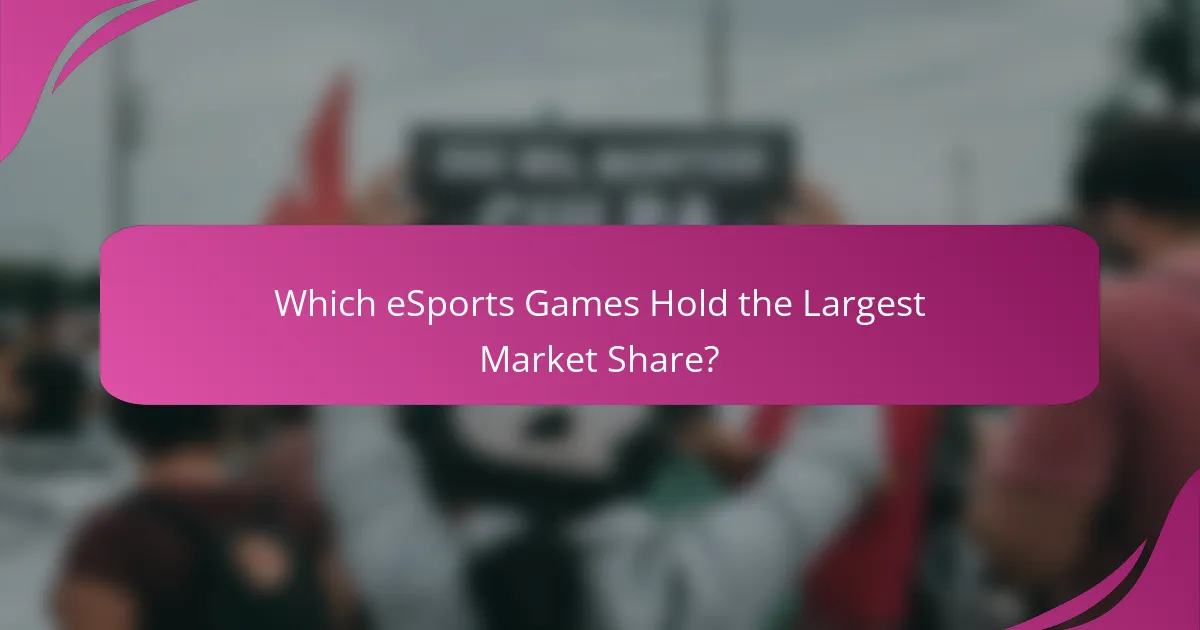The eSports landscape is characterized by a few dominant titles that command substantial market share, with games like League of Legends, Dota 2, and Counter-Strike: Global Offensive leading the charge. Recent trends indicate a shift in the industry, influenced by the rise of mobile gaming, the popularity of battle royale formats, and the growth of streaming platforms, all of which are transforming player engagement and revenue streams. Additionally, regional preferences and local gaming infrastructures play a crucial role in shaping the popularity of these games, offering valuable insights for developers and marketers aiming to connect with diverse audiences.

Which eSports Games Hold the Largest Market Share?
The eSports landscape is dominated by a few key titles that capture significant market share. Games like League of Legends, Dota 2, and Counter-Strike: Global Offensive lead the pack, driven by their large player bases, competitive scenes, and substantial sponsorship deals.
League of Legends
League of Legends (LoL) is one of the most popular eSports games, consistently holding a large market share due to its engaging gameplay and extensive competitive ecosystem. With millions of active players worldwide, LoL boasts a vibrant professional scene, including annual championships with multi-million dollar prize pools.
Key factors contributing to its success include regular updates, a diverse roster of champions, and a strong community. Players often engage in strategic team play, making it appealing for both participants and spectators.
Dota 2
Dota 2 is another heavyweight in the eSports arena, known for its complex gameplay and strategic depth. The game features a unique funding model for its premier tournament, The International, which relies on community contributions to boost prize pools, often reaching tens of millions of dollars.
The game’s steep learning curve can be daunting for newcomers, but its dedicated fan base and high-stakes competitions keep it at the forefront of the eSports market. Regular updates and a focus on competitive balance help maintain player interest and engagement.
Counter-Strike: Global Offensive
Counter-Strike: Global Offensive (CS:GO) has been a staple in the eSports community for years, known for its fast-paced gameplay and tactical depth. Its market share is bolstered by a strong competitive scene, with numerous tournaments and leagues offering substantial prize money.
CS:GO’s accessibility and relatively low system requirements make it popular among a wide range of players. The game’s emphasis on teamwork and strategy attracts both casual gamers and serious competitors, ensuring its longevity in the market.
Fortnite
Fortnite has revolutionized the eSports landscape with its unique blend of building mechanics and battle royale gameplay. Its market share surged following the introduction of competitive events, including the Fortnite World Cup, which featured impressive prize pools and attracted millions of viewers.
The game’s appeal lies in its vibrant graphics and constant updates, which keep the content fresh. However, the competitive scene is often criticized for its volatility, as shifts in game mechanics can rapidly change the landscape for players and teams.
Valorant
Valorant, a tactical shooter from Riot Games, has quickly gained traction in the eSports market since its release. Combining elements from traditional shooters with unique character abilities, Valorant offers a fresh take on competitive gameplay, appealing to both FPS enthusiasts and strategy fans.
The game has established a growing professional scene, with tournaments offering significant prize pools. Its focus on teamwork and strategy makes it a compelling choice for players looking to engage in competitive play, further solidifying its position in the eSports market.

What Are the Current Trends in eSports Market Share?
The eSports market is currently experiencing significant shifts, driven by factors such as the rise of mobile gaming, the popularity of battle royale games, and the expansion of streaming platforms. These trends are reshaping player engagement and revenue generation in the industry.
Increased Mobile Gaming
Mobile gaming is rapidly gaining traction in the eSports sector, with many players opting for games that can be played on smartphones and tablets. Titles like PUBG Mobile and Call of Duty: Mobile have attracted millions of users, contributing to a substantial portion of overall eSports participation.
As mobile devices become more powerful, developers are creating high-quality games that rival traditional console and PC offerings. This trend is particularly strong in regions like Southeast Asia, where mobile gaming often surpasses other platforms in popularity.
Rise of Battle Royale Games
Battle royale games have surged in popularity, significantly impacting the eSports landscape. Titles such as Fortnite and Apex Legends have not only attracted large player bases but have also become staples in competitive gaming tournaments.
The appeal of battle royale games lies in their dynamic gameplay and the excitement of last-player-standing scenarios. This genre has led to increased viewership and sponsorship opportunities, making it a lucrative segment of the eSports market.
Growth of Streaming Platforms
Streaming platforms like Twitch and YouTube Gaming are crucial to the growth of eSports, providing a space for players to showcase their skills and engage with fans. These platforms have transformed how audiences consume gaming content, with millions tuning in for live streams and tournaments.
As viewership continues to rise, brands are increasingly investing in sponsorships and partnerships with streamers to reach targeted demographics. This trend highlights the importance of building a strong online presence for both players and game developers in the evolving eSports ecosystem.

How Do Regional Markets Impact eSports Game Popularity?
Regional markets significantly influence the popularity of eSports games due to cultural preferences, local gaming infrastructure, and the presence of competitive leagues. Understanding these factors can help developers and marketers tailor their strategies to specific audiences.
North America
In North America, titles like League of Legends and Call of Duty dominate the eSports scene, driven by a strong gaming culture and substantial investment in professional leagues. The region benefits from high internet penetration and a robust streaming infrastructure, making it easier for players to engage with competitive gaming.
Additionally, major tournaments often attract large audiences both online and in-person, contributing to the popularity of these games. Brands and sponsors actively invest in North American eSports, further enhancing the visibility and appeal of popular titles.
Europe
Europe showcases a diverse eSports landscape, with games like Counter-Strike: Global Offensive and Dota 2 leading the charge. The region’s varied gaming preferences stem from cultural differences, with some countries favoring specific genres or titles.
European players often participate in international competitions, which boosts the visibility of their favorite games. Local leagues and tournaments, supported by sponsorships and media coverage, play a crucial role in maintaining engagement and popularity across different countries.
Asia-Pacific
The Asia-Pacific region is a powerhouse in eSports, with games such as PUBG and Mobile Legends: Bang Bang achieving massive popularity. Cultural factors, such as the rise of mobile gaming and social gaming environments, significantly influence game preferences in countries like China and South Korea.
Strong government support and investment in gaming infrastructure have led to a thriving eSports ecosystem. Local tournaments often draw large crowds, and the region’s players are known for their competitive spirit, which enhances the overall appeal of eSports games.

What Factors Influence eSports Game Market Share?
Several key factors influence the market share of eSports games, including player base size, revenue generation, and community engagement. Understanding these elements helps stakeholders identify trends and make informed decisions in the competitive gaming landscape.
Player Base Size
The size of a game’s player base is a primary determinant of its market share. A larger player base typically translates to higher visibility, more competitive events, and greater sponsorship opportunities. Popular titles like “League of Legends” and “Dota 2” boast millions of active players, which significantly boosts their market presence.
When assessing player base size, consider both active users and the game’s growth trajectory. Games that consistently attract new players or retain existing ones are more likely to maintain or increase their market share over time.
Revenue Generation
Revenue generation is crucial for determining a game’s market share. This includes income from in-game purchases, merchandise, sponsorships, and advertising. Games that successfully monetize their player base tend to have a stronger market position.
For example, titles like “Fortnite” have generated billions through microtransactions and collaborations. Understanding the revenue streams of leading games can provide insights into their market share dynamics and future potential.
Community Engagement
Community engagement plays a vital role in sustaining a game’s market share. Active communities foster loyalty and encourage player retention, which is essential for long-term success. Games with strong community support often see increased participation in tournaments and events.
Engagement can be measured through social media interactions, forum activity, and participation in live events. Developers that prioritize community feedback and create inclusive environments tend to cultivate a dedicated player base, enhancing their market share over time.

How to Analyze eSports Market Share Data?
Analyzing eSports market share data involves evaluating the popularity and revenue generation of various games within the competitive gaming landscape. Key methods include utilizing analytics tools, examining market research reports, and assessing player and viewer statistics to gain insights into trends and performance.
Using Analytics Tools
Analytics tools are essential for tracking player engagement, game performance, and audience metrics in eSports. Platforms like Twitch, YouTube Gaming, and Steam provide valuable data on viewer counts, watch time, and player activity, which can help identify trending games and shifts in market share.
When using these tools, focus on key performance indicators (KPIs) such as average concurrent viewers, peak viewership, and total hours watched. This data can reveal which games are capturing audience attention and how they compare against competitors.
Market Research Reports
Market research reports offer comprehensive insights into the eSports industry, including revenue forecasts, demographic analysis, and market trends. Reports from firms like Newzoo and Statista can provide valuable data on game popularity, sponsorship revenue, and player earnings.
When reviewing these reports, pay attention to regional differences in market share, as eSports popularity can vary significantly across countries. Understanding these nuances can inform strategic decisions for game developers and marketers.
Player and Viewer Statistics
Player and viewer statistics are critical for understanding the dynamics of eSports market share. Metrics such as the number of active players, tournament participation rates, and viewer demographics can provide a clearer picture of a game’s standing in the market.
Consider tracking changes in these statistics over time to identify growth patterns or declines. For example, a game that sees a surge in active players may indicate a successful update or marketing campaign, while a drop could suggest emerging competition or player dissatisfaction.

What Are the Key Metrics for Measuring eSports Success?
Key metrics for measuring eSports success include active players, viewership numbers, prize money distribution, and engagement rates. These metrics help stakeholders understand the popularity and financial viability of different games within the eSports ecosystem.
Active Players
Active players refer to the number of individuals who regularly engage with a game, typically measured on a monthly or daily basis. This metric is crucial as it indicates the game’s popularity and community size, which can influence sponsorship and investment opportunities.
For example, a game with millions of active players, like “League of Legends,” often attracts significant sponsorship deals and media rights. In contrast, a title with fewer active players may struggle to secure similar financial backing.
When analyzing active player counts, consider seasonal trends and game updates, as these can cause fluctuations. Tools like Steam Charts or in-game statistics can provide insights into player engagement over time.
